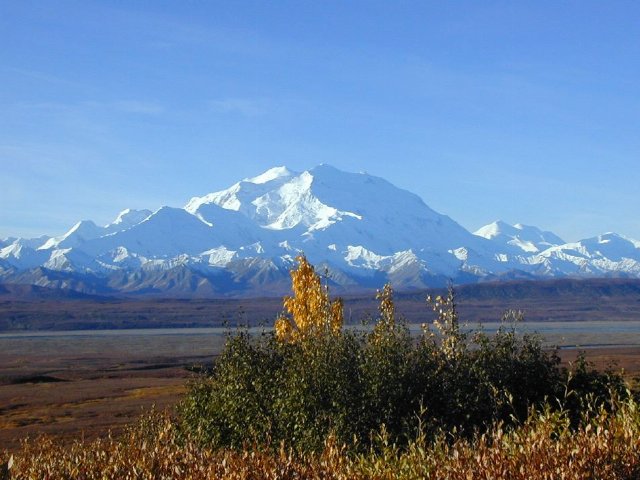Home » Regions » North America » Northwestern Forested Mountains » Boreal Cordillera » Alaska Range
Alaska Range
Last updated: February 28th, 2024
Page contents
↑About the Alaska Range
The Alaska Range is a mountain range in Southcentral Alaska. These mountains include Denali, the highest peak in North America, and owing to both their high elevation and northerly location, have some of the coldest and harshest weather not only anywhere on the continent, but in the world.Low elevations feature a subarctic continental climate, but much of the region has a tundra climate, with a few of the highest elevations reaching to an ice cap climate; the largest such region is around Denali. Total precpitation is low at low elevations but reaches to high levels at the high elevations. Unlike areas farther southeast, precipitation here coincides with the warm season, with no delay. The north-facing slopes on the margins of this region are drier, colder, and have more severe weather than the south-facing slopes that see more oceanic influence from the Gulf of Alaska and Cook Inlet.
This region consists mostly of high, steep mountains with glaciers and ice fields at high elevations. The mountains are formed of a combination of folded, faulted, and deformed regions with metamorphic rock, interspersed with granite intrusions. There are several large, active volcanoes here. The lower elevations, not covered in ice, are underlain by discontinuous permafrost.
Much of this region is completely unvegetated, covered in ice, and the highest elevations too cold to support plants even where there is exposed rock. There are a few scattered forests, only on the lowest elevations, and they consist mostly of white spruce (Picea glauca) and black spruce (Picea mariana). Most lower slopes and valley bottoms support shrubby growth of willow, birch, and alder. Mountain avens and ericaceous plants are widespread on the higher elevations capable of supporting vascular plants.
Most of this region is unpopulated, but there are some permanent settlements, mostly along the major corridors through larger valleys that cut across this region. This region is more populous than the Wrangell, St. Elias, and Pacific Coastal Mountains south and southeast from here. In spite of being colder throughout and reaching to higher elevations, this region is more accessible by roads owing in part to a number of large valleys providing access corridors across the region. The largest settlement is Healy, Alaska, with a population around 1,000; other settlements include Slana, Mentasta Lake, Cantwell, Denali Park, and Paxson. All are unincorporated. There are some abandoned mining communities here too, including Usibelli and Suntrana, and the other abandoned, once-incorporated Donnelly. At the far southwest of this region, around Iliamna Lake, there are two small communities: Kokhanok and Pedro Bay.
Land use here includes recreation, subsistence hunting and fishing, and mining of both minerals and fossil fuels. There are significant areas of protected land, including Lake Clark National Park and Preserve, Denali National Park and Preserve, and the Nelchina Public Use Area. However, overall there is less protected land here and the land use is more intensive than areas farther south and southeast.
The west portion of this region surrounds the warmer, lower-elevation, ocean-moderated Cook Inlet to the south; that region is home to Anchorage. The east of this region surrounds the slightly lower, flatter, poorly-drained, severely-cold, and sparsely-populated Copper Plateau. On either side of the Copper Plateau, there are two separate borders to the south with the Pacific Coastal Mountains, another mountainous region that is also covered with ice fields and glaciers, but has a more ocean-influenced climate. The far east end of this region is bordered to the southeast by the Wrangell and St. Elias Mountains, another mountainous region that is less ocean-influenced, slightly lower in elevation, but more isolated and less populous and with larger contiguous areas of ice fields and glaciers. At the far southwest of this region, there is a small border to the southwest with the Alaska Peninsula Mountains, a region of lower mountains with a heavily ocean-moderated climate. There is also a small border to the west with the low, flat Bristol Bay-Nushagak Lowlands. Moving into interior Alaska, along most of the length of this region, descending to lower elevations this region borders the warmer, lower-elevation Interior Forested Lowlands and Uplands, which tends to be narrow in most places.
 This photo shows Denali, for a short time known as Mt. McKinley, the tallest mountain in the Alaska Range and in all of North America. In the foreground is Wonder Lake and a flat, open landscape typical of the lower elevations around the edges of this region. Although these mountains reach to the highest elevations in North America, they are slightly more open and interrupted than the mountain ranges to the south and southeast. Photo © Skip Via (Flickr), CC BY 2.0, Source.
This photo shows Denali, for a short time known as Mt. McKinley, the tallest mountain in the Alaska Range and in all of North America. In the foreground is Wonder Lake and a flat, open landscape typical of the lower elevations around the edges of this region. Although these mountains reach to the highest elevations in North America, they are slightly more open and interrupted than the mountain ranges to the south and southeast. Photo © Skip Via (Flickr), CC BY 2.0, Source.

